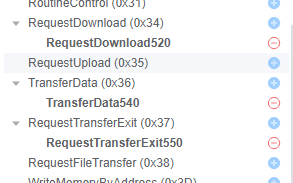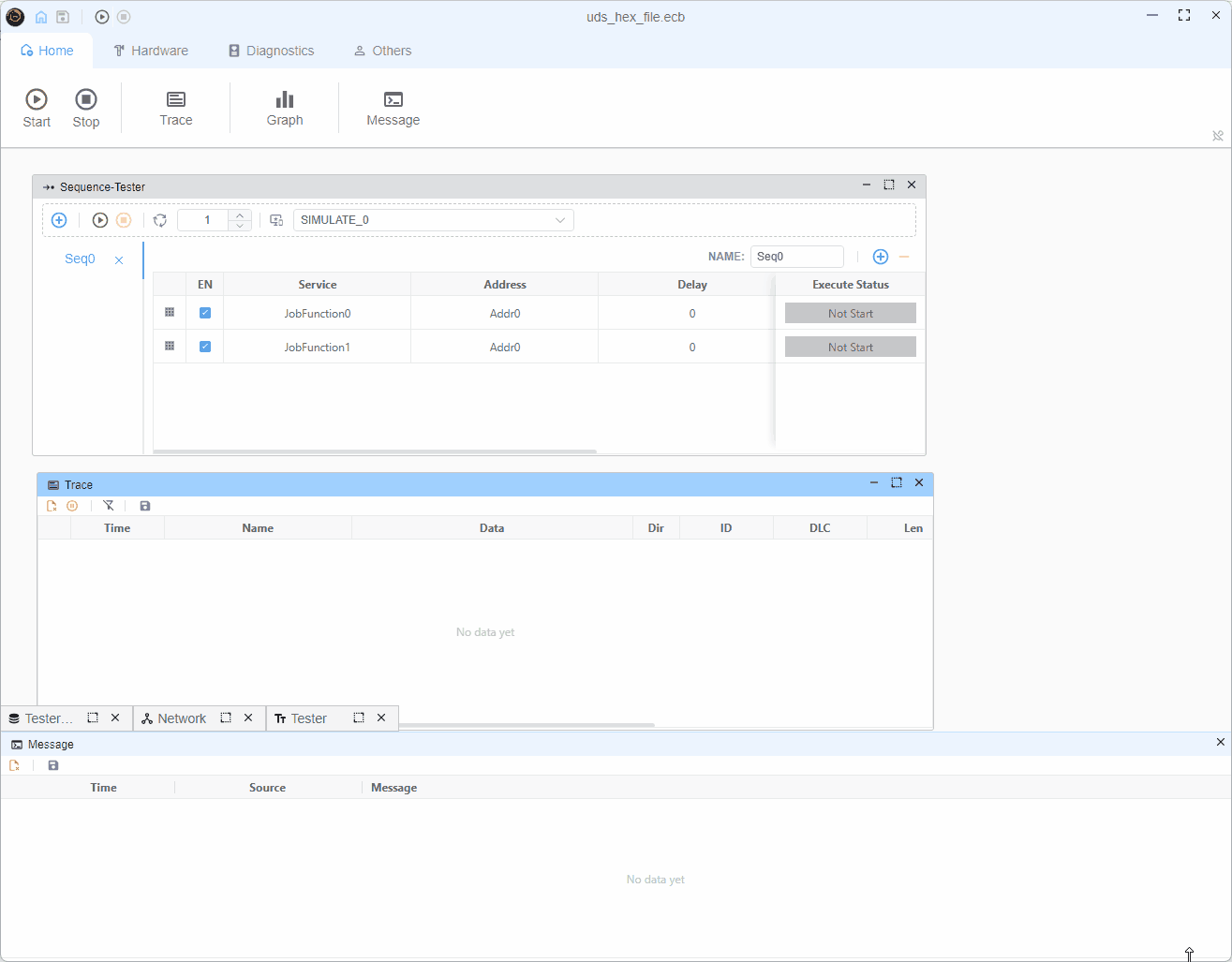UDS File Programming Example
This example demonstrates how to program hex and S-record files into an ECU using UDS (Unified Diagnostic Services) protocol. The project shows how to use HexMemoryMap and S19MemoryMap to parse Intel HEX and Motorola S-record files and program them into an ECU using block transfer.
Overview
The example implements a programming sequence using the following UDS services:
- RequestDownload (0x34)
- TransferData (0x36)
- RequestTransferExit (0x37)
Tester Config
Tester (tester.ts)

Service
- 0x34
- 0x36
- 0x37

Sequence

tester.ts Implementation Details
File Format Support
The project supports both Intel HEX and Motorola S-record formats using HexMemoryMap and S19MemoryMap:
Intel HEX Files (.hex)
const hexFile = path.join(process.env.PROJECT_ROOT, 'Hello_World.hex')
const hexStr = await fsP.readFile(hexFile, 'utf8')
const map = HexMemoryMap.fromHex(hexStr)
// Convert hex data into memory blocks
for (const [addr, data] of map) {
pendingBlocks.push({ addr, data })
}Motorola S-record Files (.s19, .srec)
const s19File = path.join(process.env.PROJECT_ROOT, 'Hello_World.s19')
const s19Str = await fsP.readFile(s19File, 'utf8')
const map = S19MemoryMap.fromS19(s19Str)
// Convert S-record data into memory blocks
for (const [addr, data] of map) {
pendingBlocks.push({ addr, data })
}Auto-Detection Example
const filePath = process.env.FIRMWARE_FILE // Could be .hex or .s19
const fileContent = await fsP.readFile(filePath, 'utf8')
const fileExt = path.extname(filePath).toLowerCase()
let map
if (fileExt === '.hex') {
map = HexMemoryMap.fromHex(fileContent)
} else if (fileExt === '.s19' || fileExt === '.srec') {
map = S19MemoryMap.fromS19(fileContent)
} else {
throw new Error(`Unsupported file format: ${fileExt}`)
}
// Both formats use the same interface
for (const [addr, data] of map) {
pendingBlocks.push({ addr, data })
}Supported File Formats
| Format | File Extensions | Record Types | Address Range |
|---|---|---|---|
| Intel HEX | .hex | :00-:05 | 16-bit with extensions |
| Motorola S-record | .s19, .srec, .s28, .s37 | S0-S9 | 16-bit (S1), 24-bit (S2), 32-bit (S3) |
Both HexMemoryMap and S19MemoryMap provide identical interfaces, making it easy to switch between formats or support both in the same application.
More details can be found in the API documentation:
Programming Flow
The programming process is divided into two main job functions:
Job Function 0 (Initial Request)
- Reads the next memory block to be programmed
- Sends RequestDownload (0x34) service with memory address and size
- Gets maximum block size from ECU response
const r34 = DiagRequest.from('Tester.RequestDownload520')
const memoryAddress = Buffer.alloc(4)
memoryAddress.writeUInt32BE(currentBlock.addr)
r34.diagSetParameterRaw('memoryAddress', memoryAddress)
r34.diagSetParameter('memorySize', currentBlock.data.length)Job Function 1 (Data Transfer)
- Splits data into chunks based on maxChunkSize
- Sends TransferData (0x36) for each chunk
- Sends RequestTransferExit (0x37) after all chunks
- Restarts process if more blocks exist
Key Features
Multi-Format Support
- Intel HEX format support (:00-:05 records)
- Motorola S-record format support (S0-S9 records with S1/S2/S3 data)
- Unified interface for both formats
- Automatic format detection based on file extension
Dynamic Block Size Adjustment
- Adjusts block size based on ECU capabilities
- Aligns to 8-byte boundaries for optimal transfer
typescriptmaxChunkSize -= 2 // Account for block sequence counter if (maxChunkSize & 0x07) { maxChunkSize -= maxChunkSize & 0x07 }Block Sequence Counter
- Implements 1-255 rolling counter for block tracking
typescriptconst blockSequenceCounter = Buffer.alloc(1) blockSequenceCounter.writeUInt8((i + 1) & 0xff)Automatic Block Management
- Queues multiple memory blocks
- Handles transitions between blocks automatically
- Restarts programming sequence for each block
- Works seamlessly with both HEX and S-record formats
Flow Diagram
ECU Simulation
Node 1(ecu.ts) simulation that responds to the programming requests. The ECU side handles three main services: 
1. RequestDownload (0x34) Response
Util.On('Tester.RequestDownload520.send', async (req) => {
const resp = DiagResponse.fromDiagRequest(req)
// Response: 0x74 (positive response)
// 0x40: length format identifier
// 0x00000081: maxNumberOfBlockLength (129 bytes)
resp.diagSetRaw(Buffer.from([0x74, 0x40, 0, 0, 0, 0x81]))
await resp.outputDiag()
})- Responds with positive response (0x74)
- Specifies maximum block length (129 bytes)
- Uses length format identifier 0x40
2. TransferData (0x36) Response
Util.On('Tester.TransferData540.send', async (req) => {
const resp = DiagResponse.fromDiagRequest(req)
// Response: 0x76 (positive response) + block sequence counter
resp.diagSetRaw(Buffer.from([0x76, Number(req.diagGetParameter('blockSequenceCounter'))]))
await resp.outputDiag()
})- Acknowledges each data block with positive response (0x76)
- Echoes back the block sequence counter
- Simulates successful data transfer
3. RequestTransferExit (0x37) Response
Util.On('Tester.RequestTransferExit550.send', async (req) => {
const resp = DiagResponse.fromDiagRequest(req)
// Response: 0x77 (positive response)
resp.diagSetRaw(Buffer.from([0x77]))
await resp.outputDiag()
})- Confirms completion of transfer with positive response (0x77)
- Simulates successful programming completion
The ECU simulation provides a complete test environment for the programming sequence, allowing developers to test their programming implementation without actual hardware. The simulation works identically regardless of whether the source file is in Intel HEX or Motorola S-record format.
Demo
